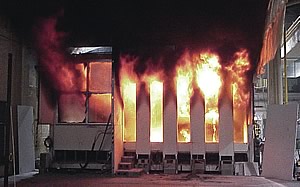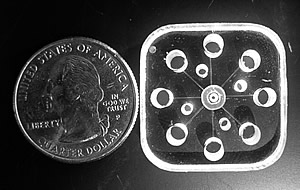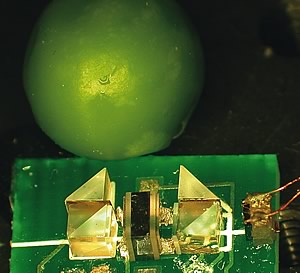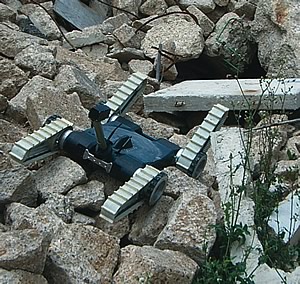Strategic Objective 2.1
Develop tools and capabilities that improve the productivity, quality, dissemination, and efficiency of research
STRATEGIC OBJECTIVE 2.1 TOTAL RESOURCES
(Dollars in Millions)
| |
FY 2000 |
FY 2001 |
FY 2002 |
FY 2003 |
FY 2004 |
FY 2005 |
FY 2006 |
FY 2007 |
| Fiscal Dollars |
$970.0 |
$819.0 |
$913.5 |
$952.8 |
$830.1 |
$878.5 |
$974.2 |
$891.0 |
| FTE – Full-Time Equivalent |
3,351 |
3,207 |
3,231 |
3,242 |
3,109 |
2,938 |
2,896 |
2,891 |
STRATEGIC OBJECTIVE 2.1 PERFORMANCE RESULTS
| Rating |
Number of Reported Results |
| FY 2000 |
FY 2001 |
FY 2002 |
FY 2003 |
FY 2004 |
FY 2005 |
FY 2006 |
FY 2007 |
| Exceeded Target |
1 |
0 |
1 |
6 |
7 |
5 |
3 |
6 |
| Met Target |
6 |
7 |
15 |
9 |
11 |
10 |
11 |
9 |
| Slightly Below Target |
5 |
2 |
0 |
1 |
1 |
0 |
1 |
1 |
| Did Not Meet Target |
3 |
5 |
5 |
4 |
3 |
0 |
0 |
0 |
Through NIST, the Department works with U.S. industry and other stakeholders to promote U.S. innovation and industrial competitiveness by advancing measurement science, standards, and technology in ways that enhance economic security and improve quality of life. NIST fulfills its broad responsibilities and works to foster science and technological leadership by helping the United States to drive and take advantage of the increased pace of technological change, fostering more efficient transactions in the domestic and global marketplace, and addressing other critical national needs assigned to NIST by the Administration and Congress.
Among its FY 2007 activities, NIST accomplished the following:
-

NIST experiments to replicate an office fire in the World Trade Center. Tests such as this helped validate computer models of the spread rate and intensity of the fires initiated by jet fuel and fed by the office furnishings and other combustibles. |
Nanotechnology and nanoscale manufacturing are key components of the American Competitiveness Initiative. In March 2006, Commerce Secretary Gutierrez announced that NIST would create a new Center for Nanoscale Science and Technology (CNST) that would offer researchers from universities, industry, and other government agencies access to state-of-the-art facilities to study a wide range of nanotechnology topics. In May 2007, NIST announced that CNST is now accepting proposals for work in nanotechnology research. CNST focuses on overcoming major technical obstacles to cost-effective manufacturing of products made with components the size of atoms and molecules by developing measurement methods, standards, and technology that help emerging nanotechnologies move from the laboratory to production. CNST is located within NIST’s Advanced Measurement Laboratory (AML), one of the most advanced research facilities of its kind in the world.
- Recommendations stemming from NIST’s three-year investigation of the World Trade Center disaster have stimulated fundamental and substantial changes in U.S. building codes and standards that represent a significant improvement in public safety over current practice. The International Code Council approved a comprehensive set of building code changes that were incorporated into the organization’s International Building Code, a model code used as the basis for building regulations promulgated and enforced by U.S. state and local jurisdictions. The code changes address such areas as the fire resistance of structural components, the use of sprayed fire-resistive materials (commonly known as fire-proofing), elevators for use by first responders, the number of stairwells, and exit path markings.
-

Core of the new NIST miniature GEMBE chemical separation device is a machined acrylic block, shown with a quarter for scale. Eight sample reservoirs for multiplexed separations form a ring around the central buffer solution port.

The newest chip-scale device—roughly the size of a pea—is a spectrometer that can be used for calibrating or stabilizing precision lasers. |
NIST researchers have developed an elegantly simple, miniaturized technique—gradient elution moving boundary electrophoresis (GEMBE)—for rapidly separating minute samples of proteins, amino acids, and other chemical mixtures. The device is easy to build with simple machining or molding techniques and low-cost polymers, enabling inexpensive mass production, and can run up to eight chemical separations simultaneously in a space about the size of a quarter, highlighting the technique’s potential for use in microfluidic “lab-on-a-chip” systems. NIST has used the device in trial separations for everything from small dye molecules and amino acids to large biomolecules, such as DNA. A prototype eight-channel GEMBE device built at NIST can produce a complete immunoassay calibration curve for insulin in a single run.
- NIST researchers have created the latest in a series of miniaturized optical instruments, which includes an atomic clock that fits on a computer chip. The newest chip-scale device—roughly the size of a pea—is a spectrometer that can be used for calibrating or stabilizing precision lasers. It could replace table-top-sized instruments used for laser calibration in atomic physics research, could better stabilize optical telecommunications channels, and perhaps could replace and improve on the precision of instrumentation used to measure chemicals or atmospheric gases. The spectrometer includes miniature optics, a microfabricated container for atoms in a gas, heaters, and a photodetector, all within a cube about 10 millimeters on a side. In telecommunications, the mini-spectrometer would offer greater precision than the physical references now used to separate fiber-optic channels, with the advantage that more channels might be packed into the same spectrum, dramatically increasing data capacity.
- In February 2007, NIST published a comprehensive report on measurement barriers to innovation, the Agency’s first ever assessment of the capacity of the Nation’s measurement infrastructure—An Assessment of the United States Measurement System: Addressing Measurement Barriers to Accelerate Innovation. In all, more than 1,000 people from industry, academia, and government contributed to the wide-ranging NIST assessment of the state of the Nation’s measurement system and its impact on innovation. The result is a snapshot appraisal that was formed by surveying measurement needs across 11 industrial sectors and technology areas. These ranged from materials to software and from building and construction to nanotechnology. Altogether, more than 700 measurement-related barriers to innovation were identified and evaluated. NIST will use this assessment to focus its own work in support of U.S. innovation and competitiveness. The report’s results and findings, along with input gathered in follow-up activities, will inform NIST’s strategic planning decisions. NIST also plans to work with other organizations in both the private and public sectors to raise awareness of the important role that advances in measurement science and technology (S&T) play in boosting innovation. A new U.S. Measurement System (USMS) office has been established at NIST to coordinate these activities.
-

Members of a NIST research team watch flames erupt from an abandoned Chicago apartment building during a November 10, 2006 test of PPV in high-rise fires. |
Members of a NIST research team watched flames erupt from an abandoned Chicago apartment building during a November 10, 2006 test of positive pressure ventilation (PPV) in high-rise fires. The controlled fires in the Windy City high-rise were part of a real-world laboratory experiment to study the effectiveness in multistory buildings of PPV, the use of powerful fans during fires to force smoke and heat from corridors and stairwells so that they stay passable and safe for both escaping occupants and entering emergency responders. In past events—such as the October 2003 blaze in a government building in Chicago where six people died—fire flow into corridors and stairwells has resulted in tragedy.
- The 2007 Baldrige Criteria for Performance Excellence incorporates some of the most significant changes in the recent history of the criteria’s evolution. The 2007 criteria address four areas of growing importance to strengthening U.S. competitiveness: (1) strategic advantages and core competencies, (2) innovation, (3) work systems, and (4) workforce engagement. In addition, several innovations tested during last year’s non-profit pilot have been incorporated in the 2007 process to identify recipients of the Malcolm Baldrige National Quality Award (MBNQA). The innovations include using a Web-based solution to conduct a “virtual consensus” discussion in order to provide all applicants with feedback reports while providing more time flexibility to the 600 volunteer examiners.
-

NIST engineers have been assisting the Department of Homeland Security in organizing a series of Response Robot Evaluation Exercises for US&R robots. |
NIST engineers have been assisting DHS in organizing a series of Response Robot Evaluation Exercises for urban search and rescue (US&R) robots. Various types of sensor-laden robots, including small survey devices that can be thrown into a disaster site; unmanned systems that can cover rugged, uneven terrain; and small, rotary-winged aerial reconnaissance drones were designed to detect injured people and trace elements of radiation in simulated natural disaster or terrorist attacks. The latest rescue robot exercise was held in June 2007, at Texas A&M’s “Disaster City” training facility in College Station, TX.
- NIST chemists have created a standardized form of common house dust to support environmental scientists studying everyday exposure to a catalog of potentially hazardous chemicals. A “standard house dust” may sound funny, but environmental scientists are quite serious about the potential for household grime to harbor harmful chemicals. For example, a 2004 study by NIST and the Environmental Protection Agency (EPA), found high concentrations of polybrominated diphenyl ethers (PBDE) in household dust. PBDEs were widely used as flame retardants in consumer products but have been phased out due to concerns over their toxicity. Once commonly used in electrical equipment as an insulator, PBDEs have not been produced since 1977 because of their toxicity, but still are found in the environment. Accurate assessment of everyday exposure to many potentially harmful contaminants is difficult because of both the complexity of the analysis and the small quantities involved. Polychlorinated biphenyls (PCB), for example, include dozens of chemically similar compounds that may be found in hundreds of combinations of only a few micrograms each in a kilogram of dust. To provide environmental scientists with an accurate baseline for calibrating their tests, NIST prepared a reference sample of typical house dust that has been certified for the concentrations of over 80 potentially hazardous chemicals.
SUMMARY OF STRATEGIC OBJECTIVE 2.1 PERFORMANCE OUTCOMES
| PERFORMANCE OUTCOME |
TARGETS MET
OR EXCEEDED |
| Promote innovation, facilitate trade, and ensure public safety and security by strengthening the Nation’s measurements and standards infrastructure (NIST) |
6 of 6 |
| Accelerate private investment in and development of high-risk, broad-impact technologies (NIST) |
2 of 3 |
| Raise the productivity and competitiveness of small manufacturers (NIST) |
4 of 4 |
| Enhance public access to worldwide scientific and technical information through improved acquisition and dissemination activities (NTIS) |
3 of 3 |
Performance Outcome: Promote innovation, facilitate trade, and ensure public safety and security by strengthening the Nation’s measurements and standards infrastructure (NIST)
The Nation’s ability to innovate and compete in a global economy depends on a robust scientific and technical infrastructure, including research, measurement tools, standards, data, and models. The NIST Laboratories develop and disseminate measurement techniques, reference data, test methods, standards, and other technologies and services required by U.S. industry to compete in the 21st century.
PERFORMANCE OUTCOME REPORTED RESULTS
| Rating |
Results |
| Exceeded Target |
2 |
| On Target |
4 |
| Slightly Below Target |
0 |
| Below Target |
0 |
NIST evaluates progress on this outcome using an appropriate mix of specific output tracking and peer review. Together, these evaluation tools, combined with continual feedback from customers provide a comprehensive picture of performance toward this long-term goal. Additional information on these evaluation methods is available at
http://www.nist.gov/director/planning/strategicplanning.htm.
Specific achievements of this performance outcome are described below:
- NIST measurement services, including calibration services, are critical for ensuring product performance and quality, improving production processes, making marketplace transactions fair and efficient, and leveling the playing field for international trade. NIST calibration services provide the customer with direct traceability to national and international primary standards. NIST offers more than 500 different types of physical calibrations in areas as diverse as radiance temperature, surface finish characterization, and electrical impedance. Beginning in FY 2007, this measure was revised to reflect the number of calibration tests performed versus the number of items calibrated. It is estimated that NIST performs 12,000 calibration tests annually.
- SRMs are the definitive source of measurement traceability in the United States; all measurements using SRMs can be traced to a common and recognized set of basic standards that provides the basis for compatibility of measurements among different laboratories. SRMs certified by the NIST Laboratories are used by customers to achieve measurement quality and conformance to process requirements that address both national and international needs for commerce, trade, public safety, and health. NIST sells more than 30,000 SRMs annually.
- Technical publications represent one of the major mechanisms NIST uses to transfer the results of its research to support the Nation’s technical infrastructure and provide measurements and standards—vital components of leading-edge research and innovation—to those in industry, academia, and other government agencies. Each year NIST’s technical staff produces a total of 2,000 to 2,200 publications with approximately 50 to 60 percent appearing in prestigious scientific peer-reviewed journals. NIST staff authors more than 1,100 publications in peer-reviewed journals each year.
- Online data represent another method NIST uses to deliver measurement and standards tools, data, and information. NIST provides online access to more than 80 scientific and technical databases covering a broad range of substances and properties from a variety of scientific disciplines. These technical databases are heavily used by industry, academia, other government agencies, and the general public, with more than 130 million estimated downloads in FY 2007.
Accomplishments and applicable quantitative data used to evaluate progress on this long-term performance outcome are reviewed quarterly. Quantitative data are collected and reported by NIST Technology Services.
External and independent evaluation of the research and measurement standards work of the NIST Laboratory Programs is conducted regularly. This type of peer review, combined with quantitative evaluation metrics focused on dissemination of NIST’s measurements and standards work, demonstrate the laboratories’ contribution to the Nation’s measurement and standards infrastructure.
In FY 2007, the National Research Council (NRC) Board on Assessment (BOA) began a process where half of the NIST Laboratories will be reviewed each year. The NRC assessments focus on the following areas:
- The technical merit of the laboratory programs relative to the current state-of-the-art worldwide.
- The degree to which the laboratory programs address national and agency priorities.
- The adequacy of the laboratories’ facilities, equipment, and human resources as they affect the quality of the technical programs.
The following quotes from NRC’s FY 2007 assessment report attest to the quality, technical merit, and relevance of NIST programs:
- Center for Neutron Research (NCNR): “There is a substantial and well-satisfied external user community. The in-house science and technology is robust.”
- Chemical Science and Technology Laboratory (CSTL): “These measurement capabilities are foundational to U.S. competitiveness, especially in new and emerging technologies. The large number of publications, committee leaderships, and visiting U.S. and foreign scientists and postdoctoral fellows testifies to [CSTL’s] technical reputation and leadership position in measurement science.”
- Electronics and Electrical Engineering Laboratory (EEEL): “This combination of innovation and technical achievement promises to serve well the emerging technologies of the future.”
- Information Technology Laboratory (ITL): “The work at ITL generally ranks at or near the top of the work being done by peer institutions.”
These reports are available at http://www.nist.gov/director/nrc.
In addition to peer reviews, the programmatic goals and strategic direction of NIST as a whole are reviewed regularly by the Visiting Committee on Advanced Technology (VCAT). The VCAT is a legislatively mandated panel of external advisors that meets quarterly to review NIST’s general policy, organization, budget, and programs. In its most recent annual report, the VCAT recognized the world renowned professional accomplishments contributing to NIST’s ability to attract world class researchers, a NIST competitive advantage. See http://www.nist.gov/director/vcat/index.htm for additional information on the VCAT, including its most recent annual report.
Performance Outcome: Accelerate private investment in and development of high-risk, broad-impact technologies (NIST)
ATP provides cost-shared funding to businesses to develop high-risk, innovative new technologies for commercial use. ATP held a single competition for funding during FY 2007.
PERFORMANCE OUTCOME REPORTED RESULTS
| Rating |
Results |
| Exceeded Target |
0 |
| On Target |
2 |
| Slightly Below Target |
1 |
| Below Target |
0 |
Key indicators of the generation and diffusion of new commercially relevant technical knowledge include patents and technical publications generated by ATP-funded projects and ATP-funded projects with technologies under commercialization. The long-term nature of ATP-funded projects results in a three to five-year lag from initial project funding to the generation of measurable outputs and outcomes.
Specific achievements of this performance outcome are described below:
- Publications and patents represent major channels for the diffusion of technical knowledge that results from ATP investment in the development of new technologies. Past ATP-funded research generated more than 1,900 cumulative publications and more than 1,500 cumulative patents through FY 2006.
- The number of ATP-funded projects with technologies under commercialization is an indication of the extent to which ATP-funded research leveraged or catalyzed new products and services. Through FY 2006, over 370 ATP projects have technologies under commercialization.
- The program met its targets for commercialization and publications, though it slightly missed its target for patents (1,507-actual, 1,510-target).
Evaluation is a central part of ATP’s operation. ATP uses a variety of methods, including internal assessments, external program reviews, and economic impact studies to assess and evaluate the program. Additional information on ATP’s evaluation methods is available at http://www.atp.nist.gov/eao/eao_main.htm.
The measures above, along with other programmatic accomplishments, are used to evaluate ATP’s progress towards its long-term goal of increasing investment in and development of new technologies. Data are gathered from the portfolio of ATP project participants through ATP’s Business Reporting System (BRS). BRS reports are reviewed by ATP’s Economic Assessment Office and the individual project managers overseeing the ATP project.
The programmatic objectives and management of ATP are reviewed by the ATP Advisory Committee. Additional information on the ATP Advisory Committee, including recent annual reports, is available at http://www.atp.nist.gov/adv_com/ac_menu.htm. ATP was abolished by the America COMPETES Act (Public Law 110-69) which was signed by the President on August 9, 2007. However, this statute allows for continued support for previously awarded ATP projects and the 56 new FY 2007 awards.
Performance Outcome: Raise the productivity and competitiveness of small manufacturers (NIST)
The most significant challenge facing U.S. manufacturers continues to be coping with accelerating technological change and global competition. The firms that succeed will be those best able to manage the complexity and rapid change affecting all aspects of the manufacturing enterprise. Through the Hollings Manufacturing Extension Partnership (MEP) program’s nationwide network of manufacturing centers, which are linked to state, university, community college, and private sources of technology and expertise, NIST helps smaller firms adopt new and advanced manufacturing and management technologies and innovative business practices to position them to compete in the global economy.
PERFORMANCE OUTCOME REPORTED RESULTS
| Rating |
Results |
| Exceeded Target |
4 |
| On Target |
0 |
| Slightly Below Target |
0 |
| Below Target |
0 |
The Nation’s approximately 350,000 small manufacturers employ over 11 million people providing intermediate parts and equipment that contribute more than half of the value of U.S. manufacturing production. Their role in manufacturing supply chains is crucial; and the Nation’s future manufacturing productivity and competitiveness rests largely on the ability of these establishments to raise their efficiency, lower their costs, and implement a culture of innovation into their business operations. Hollings MEP helps companies transform themselves into high performance enterprises—productive, innovative, customer-driven, and competitive—by efficiently providing high value technical and advisory services, including access to industry best practices.
MEP clients receive technical, business, and innovation services through interactions ranging from informational seminars and training to in-depth technical assistance in areas such as new product development and implementation, quality improvement practices, human resources and organizational development, and industrial marketing.
Specific achievements of this performance outcome are described below:
- MEP’s network of manufacturing assistance centers works at the grassroots level with each center providing their local manufacturers with expertise and services tailored to their most critical needs. In FY 2006, MEP centers provided services to over 16,000 clients in industries such as fabricated metal products, computer and electronic products, and transportation equipment.
- Through an annual survey of clients, the program obtains quantifiable impacts of MEP services on its clients’ bottom line. MEP demonstrates the impact of its services on three key quantitative business indicators that, as a set, suggest the presence of business changes that are positively associated with productivity, revenue growth, and improved competitiveness. The measures include: (1) increased sales attributed to MEP assistance, (2) increased capital investment attributed to MEP assistance, and (3) cost savings attributed to MEP assistance.
The performance measures, along with other programmatic accomplishments, are used to evaluate progress on this long-term performance goal. MEP’s Client Impact Survey is administered by a private firm. Each quarter, the data is reviewed by NIST MEP staff and center staff. Based on defined criteria, impacts are selected by NIST MEP for confirmation and verification by center staff.
As with other NIST programs, the programmatic objectives and management of MEP are reviewed by the VCAT and MEP’s National Advisory Board (NAB), which was established by the Secretary of Commerce in October 1996. Recently, the charter for the MEP NAB was amended to add flexibility and respond to the program’s shift in emphasis to enhancing firms’ innovation capabilities. NIST is now in the process of selecting additional board members. The first meeting of the reconstituted board was held in March 2007.
Performance Outcome: Enhance public access to worldwide scientific and technical information through improved acquisition and dissemination activities (NTIS)
Bringing scientific and technical information to U.S. business and industry.
PERFORMANCE OUTCOME REPORTED RESULTS
| Rating |
Results |
| Exceeded Target |
0 |
| On Target |
3 |
| Slightly Below Target |
0 |
| Below Target |
0 |
NTIS seeks to promote innovation and economic growth for U.S. business by (1) collecting, classifying, coordinating, integrating, recording, and cataloging scientific and technical information from a variety of sources, foreign and domestic; (2) disseminating this information to the public; and (3) providing information management services to other federal agencies that help them interact with and better serve the information needs of their own constituents, and to accomplish this without appropriated funds.
In FY 2007, NTIS partnered with the Government Printing Office (GPO) in an effort to provide the Federal Depository Libraries with access to many of its electronically-stored documents. NTIS and GPO began conducting a beta test pilot project with 29 Federal Depository Libraries using a new interface NTIS developed to support the program implementation. The project included access to approximately 240,000 full text publications dating from 1964 to 2000 that were available for downloading, at no charge. The results of the beta test were very positive and program participation is now offered to all 1,262 Depository Libraries. There are currently over 340 Depository Libraries participating in the program, and that number is expected to continue to grow making invaluable research results more readily available to the U.S. public.
NTIS has successfully contributed to the White House initiative prompting improved early childhood development programs for the Nation’s children, through the storage and distribution of the materials developed by the Departments of Health and Human Services (HHS), Education, and Agriculture (USDA). The program is called the “Healthy Start, Grow Smart” program and provides easily understood information booklets to parents and caregivers about best practices in early childhood development. The information is published in English, Spanish, Vietnamese, and Chinese providing valuable age-appropriate information about health, safety, nutritional needs, and early cognitive development. NTIS manages the storage and distribution of over 10 million booklets annually, and anticipates increased dissemination in the future.
STRATEGIES AND FUTURE PLANS
NIST uses a variety of methods, including hosting conferences and workshops; participating on standards committees; and ongoing interactions with industry, professional groups, universities, and other government agencies to identify the needs of its diverse customers. In FY 2007, NIST supplemented its usual large number of conferences and workshops with a special series of private-public sessions for the USMS—all aimed at identifying priority measurement needs impeding future technological innovations. NIST led this comprehensive assessment of the USMS, and NIST scientists continued to work closely with industry on developing R&D roadmaps. Through these private-public collaborations, priority measurement needs from across industry and the economy are identified, along with potential solutions and viable solutions providers. In addition, NIST conducts retrospective and prospective economic impact studies annually to prioritize R&D funding and ensure that the Department conducts the highest priority research.
In 2006, MEP developed a Next Generation strategic plan focused on providing the innovation services that U.S. manufacturers need to grow, transform, and remain globally competitive. The plan includes a much stronger emphasis on providing technology-intensive services to U.S. small manufacturers. The Next Generation MEP will continue to leverage and expand relationships, partnering at both the federal and state level with organizations that have complementary goals focused on meeting the most pressing needs of the manufacturing community. MEP’s planning process is ongoing, with input from a stakeholder list that includes small manufacturers, state representatives and economic development partners, manufacturing related associations, universities, community colleges, and MEP center staff—as well as national stakeholders in the Departments of Commerce, Labor (DOL), and Defense (DOD). This broad level of input provides a more complete picture of national manufacturing needs, the manufacturing infrastructure in which the MEP centers operate, and the priorities of the manufacturing community.
Special attention is being given to documenting the results of funded research to ensure maximum private sector use is made of this investment in the years ahead.
A new Technology Innovation Program (TIP) at NIST was authorized by the America COMPETES Act. TIP was established to support, promote, and accelerate innovation in the United States through high-risk, high-reward research in areas of critical national need. TIP is aimed at speeding the development of high-risk, transformative research targeted to address key societal challenges. Funding could be provided to industry (small and medium-sized businesses), universities, and consortia for research on potentially revolutionary technologies for meeting critical national needs that present high technical risks with commensurate high rewards if successful. The primary mechanism for this support would be cost-shared research grants, cooperative agreements, or contracts awarded on the basis of merit competitions.
NIST will continue to explore new models of public-private partnerships to encourage industry investment in R&D. The goal of these partnerships is to accelerate and promote innovation.
The Internet has provided NTIS with a great opportunity to shift from traditional information collection and dissemination activities and has expanded the end-user opportunities. As customer expectations and technology have changed, NTIS has continued to be a leader in information collection and dissemination activities, through development of highly sophisticated platforms.
In 2007, NTIS launched advanced search and navigation features for searching the NTIS Web site. This will allow users to more easily find documents from among the NTIS collection of over 2.5 million technical reports.
NTIS also assisted other federal government agencies in making information easier to find and order with the implementation of easy-to-use online ordering capabilities for USDA and the Centers for Medicare and Medicaid Services (CMS). This allows the public to more easily access nutritional and childhood development information from these agencies.
CHALLENGES FOR THE FUTURE
Keeping the U.S. competitive edge in the world economy depends on the Nation’s ability to generate and harness the latest in scientific and technological developments—particularly in the physical sciences and engineering—and to apply these developments to real world applications. Throughout the last decade, political and technical forces have combined to open up much of the globe to commerce. Increased emphasis on the sciences has created an environment in which continuous innovation must be sustained to maintain economic success. These growth and competition trends have significant implications for U.S. technological leadership and the economic growth and jobs it generates; R&D and high-tech manufacturing strategies; competition for high-skilled workers; and the climate for attracting global investment. Technological innovation ensures continued U.S. leadership in S&T, which provides a competitive advantage that drives productivity and growth for the U.S. economy.
The Department’s key role in the President’s American Competitiveness Initiative, which strives to keep the United States strong and secure by ensuring that it continues to lead the world in S&T, reflects the importance of technological innovation to the Nation’s economic future. The Department will continue to conduct high-priority research, identify technical measurement barriers to innovation, and transfer technical knowledge developed to the private sector as part of efforts to drive this initiative.
|


